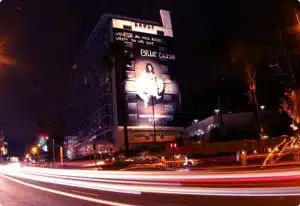What Is a Wallscape? Info on Biggest OOH ads
Wallscapes offer the perfect way to stand out in a crowded area. They provide a launchpad for big, innovative campaigns, and they give advertisers a chance to exercise creative muscle.
You may have heard the term “wallscape,” but do you know what it really means? Wallscapes are a hybrid between billboards and urban art installations — combining large-scale advertising with visually bold designs that demand attention. They’re even more impactful than traditional billboards, often incorporating unique elements that blend seamlessly with the surrounding architecture.
Wallscapes offer a powerful way to stand out in busy urban environments, giving brands a platform for bold, innovative campaigns. Their larger-than-life presence allows advertisers to stretch creative boundaries and leave a lasting impression on their audience.
Wondering if a wallscape is right for your next album drop, product launch, or brand campaign? Read on to explore the benefits of wallscapes, how they differ from traditional formats, and how top brands have used them to make unforgettable statements.
What is a Wallscape?

Wallscapes are large-scale outdoor advertisements displayed on building walls. As one of the biggest forms of out-of-home advertising, they are often 2-5 times the size of a standard billboard. Unlike billboards, wallscapes don’t adhere to a standard size or format; they are tailored to fit the unique shape and character of the wall they occupy. Some wallscapes even extend beyond their surfaces, incorporating the surrounding environment like sidewalks or parking areas for added visual impact.
Creating a wallscape requires extensive planning, technical expertise, and a creative vision. Because of the intricate design process and significant investment involved, wallscapes typically remain in place longer than traditional billboards, maximizing their impact on audiences.
What Is the Difference Between a Wallscape and a Billboard?
The primary differences between wallscapes and billboards are their size and structure. Wallscapes are significantly larger, often dominating urban environments with their bold designs. They are mounted on building walls in cities, while billboards are freestanding structures typically found along highways or rural roads. Both formats are visible from a distance, but wallscapes offer greater customization and integration with their surroundings.
How Are Wallscapes Created?

Wallscapes come in three main formats: vinyl, handpainted, and digital. Vinyl wallscapes involve printing the creative design onto vinyl, which is then affixed to the wall using grommets or adhesive. Handpainted wallscapes are works of art, often becoming attractions as passersby watch the muralists at work. Digital wallscapes are the most modern option, functioning like digital billboards, with dynamic content and special effects.
Additional features like 3D extensions, LED screens, neon tubing, and strobes can enhance wallscapes further, drawing even more attention to the advertisement.
Why Choose a Wallscape?
Wallscapes offer unique advantages over traditional billboards, making them a powerful tool for advertisers. Here’s why you should consider a wallscape:
- Exceptional creative: The size and scale allow for intricate designs and storytelling, making a lasting impression.
- Limited competition: Wallscapes are often found in areas where other outdoor advertising is restricted, ensuring your message stands out.
- Big impact: Their eye-catching nature draws attention from pedestrians, commuters, and even the media.
- Social media buzz: Stunning wallscapes frequently go viral on platforms like Instagram, extending your campaign’s reach well beyond its physical location.
- Exceptional reach: Wallscapes dominate their environment, commanding attention and targeting a broad demographic.
Wallscapes That Stand Out
Wallscapes have become an iconic part of the urban advertising landscape. Some of the most memorable examples include:
- Nationwide Insurance’s yellow paint spill, which extended beyond the wall onto the parking lot below.
- A CBS campaign featuring “Magnum, P.I.” with a series of wallscapes displaying the show’s lead character.
- Chevy’s Bolt wallscape, showcasing an electric car with a charging cord connecting to a nearby building.
- Utah’s Mighty 5 campaign, featuring stunning red rock landscapes on Wilshire Boulevard.
Wallscape Advertising Costs by City
City Format Estimated Monthly Cost Los Angeles Printed or Vinyl $15,000 – $50,000 New York City Painted or Printed $25,000 – $75,000 Chicago Vinyl or Mesh $10,000 – $30,000 Miami Printed $8,000 – $25,000 San Francisco Printed Vinyl $12,000 – $35,000 Atlanta Mesh or Vinyl $6,000 – $20,000 Seattle Printed $7,000 – $18,000 Philadelphia Vinyl Wrap $9,000 – $22,000 Austin Printed $5,000 – $15,000
Want to learn more about how wallscapes can elevate your advertising strategy? Contact us today to explore opportunities for your brand.

NCT Wallscape Beverly Hills

Dolce & Gabbana x Khaled Khaled Sunset Blvd billboard

Billie eilish wallscape sunset blvd.
